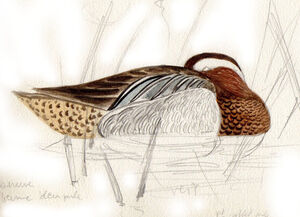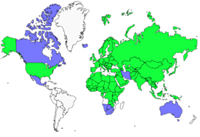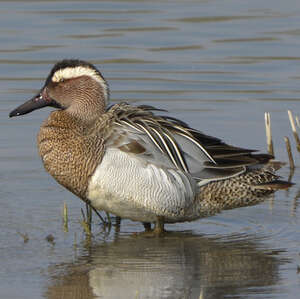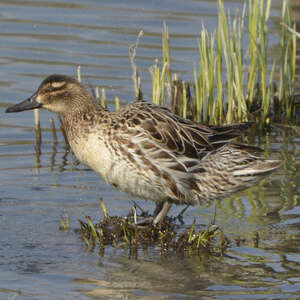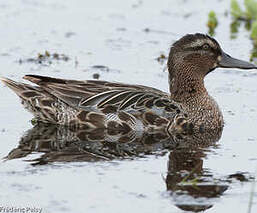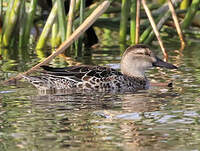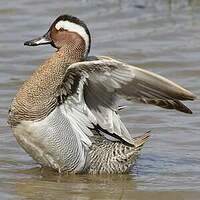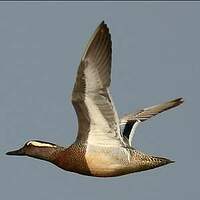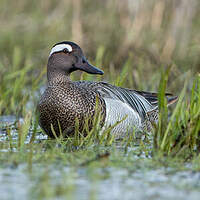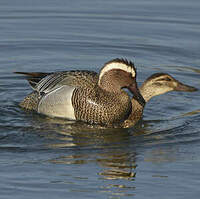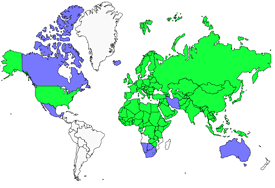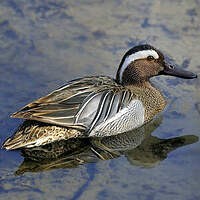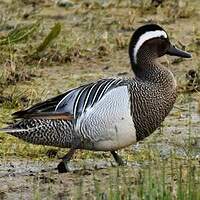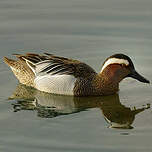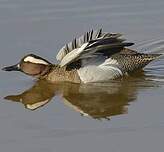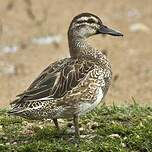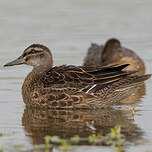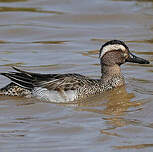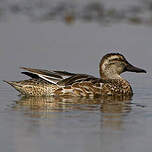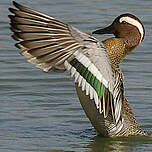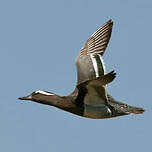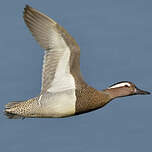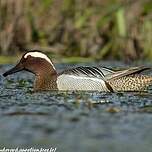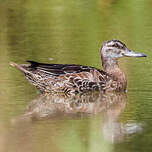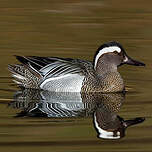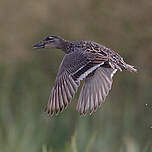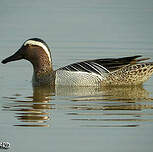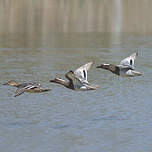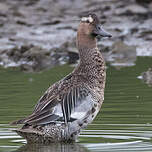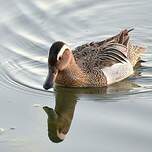Garganey
Spatula querquedula - Sarcelle d'été
Identification
Garganey is a small, surface-feeding duck, slightly larger than its cousin, the Winter Garganey. The adult male can be recognised at first glance by its long white eyebrow going up to the neck, tapering off, outlined by the blackish cap and highlighted by the vine-coloured cheeks. To identify the rest, just look at a beautiful profile photo showcasing the finely grey speckled white flanks and the long grey scapulars above them. In flight, the wings display their attraction. Above, the grey covert feathers of the arm precede the mirror of the secondary white remiges centred with dark green. Underneath, an originality; the bird appears bicoloured, dark at the front (in front of the wing, head, neck and chest) and light at the back in strong contrast, particularly the rest of the white alar coverts. The beak is dark, brownish-red, and the iris is honey-coloured.
The adult female has nothing in common with the male except the silhouette, of course, and the mirror of the wing, however narrower. The plumage is a combination of brown and very cryptic beige. As with the male, it is necessary to focus the attention on the head if there is no male nearby. This is marked laterally by three longitudinal stripes going from the beak to the neck, one blackish-brown passing by the eye and the two others, whitish on each side of the first. A unique case among our ducks. Often, a clear spot can be observed against the base of the beak. In addition to the size and stature, one can also pay attention to the bicoloured mirror of the wing.
The juvenile cannot be distinguished from the female. Plumage may be a bit warmer and more finely marked ventrally.
Subspecific information monotypic species
Foreign names
- Sarcelle d'été,
- Cerceta carretona,
- marreco,
- Knäkente,
- böjti réce,
- Zomertaling,
- Marzaiola,
- årta,
- Knekkand,
- kačica chrapačka,
- čírka modrá,
- Atlingand,
- heinätavi,
- Somereend,
- xarrasclet,
- Taumönd,
- cyranka (zwyczajna),
- prīkšķe,
- reglja,
- Чирок-трескунок,
- Itik jurai,
- シマアジ,
- 白眉鸭,
- เป็ดลาย,
- 白眉鴨,
Voice song and cries
The contact call is a common duck sound, rreeiin, rreeiin,..., usually repeated and not particularly distinctive. On the other hand, the voice of the male in parade is. It is a sharp crackling, somewhat like the sound a metal blade would make on the teeth of a comb, again repeated. It is very curious and unmistakable.
Habitat
In the breeding habitat, one or more shallow fresh water ponds surrounded by well-developed wetland vegetation in a variable but more open context (meadow, agricultural or uncultivated areas) are included. In winter, the range is wider as it comprises freshwater or brackish and partially submerged (estuaries, lagoons, rice fields, etc.) coastal habitats that are well vegetated.
Behaviour character trait
Discreet bird, which, were it not for the male's parade calls, would pass easily unnoticed in the spring. It keeps in family groups after breeding, no intense gregariousness at this time of year as with other species. On the other hand, during the wintering period, large groups can be seen in open waters, allowing for counts.
Dietfeeding habits
The Garganey mainly feeds at night in shallow waters by tipping its body. Its diet varies according to the seasons and individuals. For example, females and chicks in reproduction will have a more animal-based diet, richer in proteins (worms, larvae and adults of insects, crustaceans, mollusks). During winter, its diet is more vegetable-based, but still rich thanks to the seeds of higher plants (wild rice and other grasses for example).
Reproduction nesting
In our countries, the Garganey arrives at the breeding sites in April and breeding takes place in May. Nesting takes place on the outskirts of water bodies in wild grassy areas, but also in crops, which can be fatal to the nest.
The female lays an average of 9-10 eggs which she will incubate alone for about 3 weeks. Incubation starts once the clutch is complete so that hatching is synchronous. The young will take flight after 5 weeks of development under the supervision of their mother.
Geographic range
The Garganey breeds across the entire length of the Palearctic region, from Iceland to Japan, mainly between 40 and 65 degrees North. It is a long-distance migrant. It winters in Africa, the Arabian Peninsula, India and South East Asia, as far as Papua New Guinea, but not in Australia.
Threats - protection
IUCN conservation status
concern
in the Wild
threatened
evaluated
We can guess. As with many other waterbirds, the species is edible and despite its small size, it is still hunted indiscriminately in southern wintering grounds. Fortunately, this is no longer the case in the north but here it faces other difficulties (habitat destruction, drainage, conversion to cultivation, agricultural works, nature tourism, etc.) that make its populations vulnerable.
It is estimated that globally, the population has dropped by 25% in 20 years, which is not a good sign for the future without a significant change in the management of environments and species, globally.
Sources of information
- IOC World Bird List (v14.1), Gill, F and D Donsker (Eds). 2023.
- xeno-canto, Sharing bird sounds from around the world,
- Birds of the World, The Cornell Lab of Ornithology
- Canards, cygnes et oies d'Europe, d'Asie et d'Amérique du Nord, Reeber Sébastien
- Ducks, Geese and Swans, Kear, J
- Guide des canards, des oies et des cygnes, Steve Madge
- Les palmipèdes d'Europe, Géroudet P., MAJ M. Cuisin
- The Handbook of Bird Identification for Europe and the Western Palearctic, Mark Beaman, Steve Madge
Other sources of interest
 Specification sheet created on
10/11/2023 by Jean François
Specification sheet created on
10/11/2023 by Jean FrançoisTranslation by AI Oiseaux.net
published: 08-11-2023 - Updated: 08-11-2023
© 1996-2024 Oiseaux.net
- Accipitriformes
- Aegotheliformes
- Anseriformes
- Apodiformes
- Apterygiformes
- Bucerotiformes
- Caprimulgiformes
- Cariamiformes
- Casuariiformes
- Charadriiformes
- Ciconiiformes
- Coliiformes
- Columbiformes
- Coraciiformes
- Cuculiformes
- Eurypygiformes
- Falconiformes
- Galliformes
- Gaviiformes
- Gruiformes
- Leptosomiformes
- Mesitornithiformes
- Musophagiformes
- Nyctibiiformes
- Opisthocomiformes
- Otidiformes
- Passeriformes
- Pelecaniformes
- Phaethontiformes
- Phoenicopteriformes
- Piciformes
- Podargiformes
- Podicipediformes
- Procellariiformes
- Psittaciformes
- Pterocliformes
- Rheiformes
- Sphenisciformes
- Steatornithiformes
- Strigiformes
- Struthioniformes
- Suliformes
- Tinamiformes
- Trogoniformes

